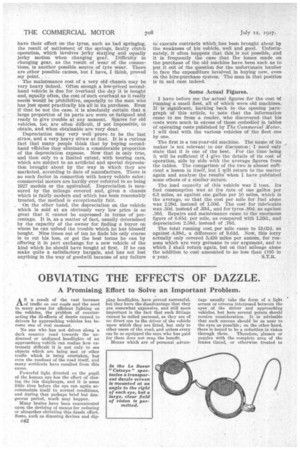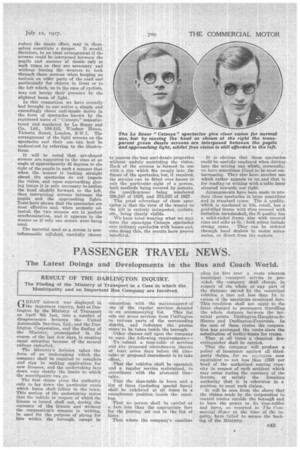OBVIATING THE EFFECTS OF DAZZLE.
Page 64

Page 65

If you've noticed an error in this article please click here to report it so we can fix it.
A Promising Effort to Solve an Important Problem.
A S a result of the vast increase tiof traffic on our roads and the need in many areas for efficient lighting on the vehicles, the problem of counteracting the ill-effects of dazzle caused to drivers by approaching vehicles has become one of real moment.
No one who has notdriven along a dark country road towards the undimmed or undipped headlights of an approaching vehicle can realize how extremely difficult it is not only to see objects which are being met or other traffic which is being overtaken, but even the confines of the road itself, and many accidents have resulted from this cause.
Powerful light directed on the pupil of the human eye has the effect of closing the iris diaphragm, and it is some little time before the eye can again accommodate itself to normal conditions, and during that perhaps brief but dangerous period, much may happen.
Many brains have been concentrated upon the devising of means for reducing or altogether obviating this dazzle effect. Some, such as dimming devices and dip
C4.2
ping headlights, have proved successful, but they have the disadvantage that they are somewhat expensive, and still more important is the fact that such fittings cannot be called personal, as they are of no direct use to the driver of the vehicle upon which they are fitted, but only to other users of the road, and unless every car be so equipped the man who has paid for them does not reap the benefit.
Means which are of personal advan Vigo usually take the form of a light screen or screens interposed between the eyes of the driver and approaching vehicles, but here several points should receive consideration. It is advisable that such screens should be as near to the eyes as possible; on the other hand, there is bound to be a reduction in vision through them. Therefore, glasses or goggles with the complete area of the lenses tinted, or otherwise treated to reduce the dazzle effect, may in themselves constitute a danger. It would, therefore, be an ideal arrangement if the screens could be interposed between the pupils and sources of dazzle only at such times as they are necessary and without forcing the wearers to look through these screens when keeping an outlook on other parts of the road and particularly for objects in front or to the left which, as in the case of cyclists, may not betray their presence by the slightest beam of light.
In this connection we have recently had brought to our notice a simple and exceedingly clever anti-dazzle device in the form of spectacles known by the registered name of " Catseye," manufactured and marketed by Le Sueur and Co., Ltd., 184-185, Windsor House, Victoria Street, London, S.W.1. The arrangement of the light screens on the spectacles and their use can best be understood by referring to the illustrations.
It will be noted that arc-shaped screens are supported in the rims at an angle of approximately 45 degrees to the right of the pupils in such a manner that when the wearer is looking straight ahead the spectacles do not impede the vision, and upon approaching glaring lamps it is only necessary to incline the head slightly forward to the left, thus interposing screens between the pupils and the approaching lights. Tests have shown that the spectacles are most effective and, when properly adjusted, the two screens are in perfect synchronization, and it appears to the wearer as if only one screen were being used.
The material used as a screen is noninflammable celluloid, carefully chosen to possess the best anti-dazzle properties without unduly restricting the vision. Each of the screens is formed in one with a rim which fits snugly into the frame of the spectacles, but, if require& the screens can be fitted over lenses to suit the particular sight of a person, both methods being covered by patents. the specifications being numbered 266,245 of 1926, and 2'12,825 of 1927.
The great advantage of these spectacks is that the view of the wearer to the left is entirely unimpeded, cyclists, etc., being clearly visible.
We have tried wearing what we may term the open-type Catseye spectacles over ordinary i-pectackss with lenses and, even doing this, the results have proved benetici al. It is obvious that these spectacles could be usefully employed when driving into the setting sun which, personally, we have sometimes found to be most embarrassing. They also have another use which rather appeals to us, and that is for reading or writing with a table lamp situated towards our right.
Arrangements have been made to produce these spectacles in large quantities and in standard types. The A quality, which is marketed at 10s. retail, has a. gold-filled frame with rims covered with imitation tortoiseshell, the B quality has a solid-nickel frame also with covered rims and sells at 6s. ; both prices include strong cases. They can be ordered through local dealers in motor accessories, or direct from the makers.












































































































